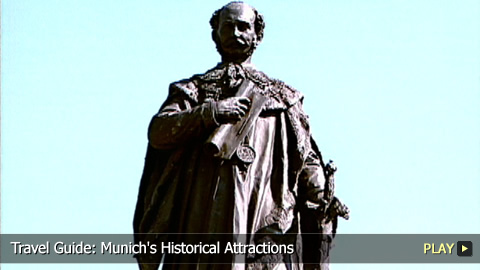Travel Guide: Munich's Historical Attractions

advertisement
VOICE OVER: Rebecca Brayton
Germany boasts a rich history, and as one of the country's main cities, Munich has played an important part in that story. Today's tourists can benefit from this history in the form of wonderful attractions located throughout the city. From ancient fortifications that once protected the city, to statues that commemorate important events and individuals, there is a variety of sites to see. For example, Maximilianstrasse is named for King Maximilian II of Bavaria, and is an important street for shopping and culture. In this video, http://www.WatchMojo.com explores a few of the top historical attractions found in Munich, Germany.
Isartor
During the Middle Ages, fortifications protected the city center. As the city expanded, these walls were torn down, though pieces remain to this day. Found just west of Marienplatz, the Isartor is a gate built in 1337. It is the most historic of all the remaining gates, and as such has been renovated and restored a number of times throughout its history. An elaborate fresco decorates the gate, and depicts a fourteenth century war triumph.
Siegestor
The Siegestor, or Victory Gate, is a symbol for peace in the city since being destroyed and partially rebuilt in the wake of World War II. When it was restored, an inscription was marked on its back side that reads: “Dedicated to victory, destroyed by war, reminding of peace.” Originally built in the nineteenth century, this tri-arched gate was meant to represent the Bavarian army’s courage during the Napoleonic War. Similar in style to the Arc de Triomphe in Paris, the Bavarian arch is adorned with winged statues, depictions of battle scenes and finally a lion-drawn chariot found at its peak.
The Angel of Peace
Found in a suburb of the city, the Angel of Peace is a monument erected at the end of the nineteenth century. It was originally meant to commemorate the 25-years of peace that followed the Franco-Prussian war. A 75-foot tall Corinthian column is capped with a golden sculpture of the Greek goddess of victory, Nike. A set of double staircases surrounds an elaborate terrace and fountain, and leads to an observation level above.
Maximilianstrasse
Maximilianstrasse is named for King Maximilian II of Bavaria, who ruled in the mid-nineteenth century. While this street is one of Munich’s four royal avenues, today it is also known as a place to find high-end shopping and art galleries. When it was built, it was the King’s aim to build a dynamic boulevard, and to combine the best aspects of various architectural styles and modern technology. He is honored with a statue on the eastern part of the avenue.
Whether it’s to honor peace, victory or a King, Munich is full of historical landmarks that are well worth the visit.
Sign in
to access this feature
